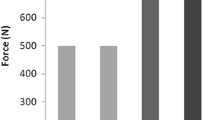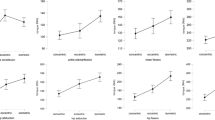Abstract
Purpose
The purpose of the present study was to investigate the influence of strength outcome [maximal voluntary contraction (MVC) torque vs. rate of torque development (RTD)], motor task (unilateral vs. bilateral) and muscle group (knee extensors vs. flexors) on the magnitude of bilateral deficits and inter-limb asymmetries in a large heterogeneous group of athletes.
Methods
259 professional/semi-professional athletes from different sports (86 women aged 21 ± 6 years and 173 men aged 20 ± 5 years) performed unilateral and bilateral “fast and hard” isometric maximal voluntary contractions of the knee extensors and flexors on a double-sensor dynamometer. Inter-limb asymmetries and bilateral deficits were compared across strength outcomes (MVC torque and multiple RTD measures), motor tasks and muscle groups.
Results
Most RTD outcomes showed greater bilateral deficits than MVC torque for knee extensors, but not for knee flexors. Most RTD outcomes, not MVC torque, showed higher bilateral deficits for knee extensors compared to knee flexors. For both muscle groups, all RTD measures resulted in higher inter-limb asymmetries than MVC torque, and most RTD measures resulted in greater inter-limb asymmetries during unilateral compared to bilateral motor tasks.
Conclusions
The results of the present study highlight the importance of outcome measure, motor task and muscle group when assessing bilateral deficits and inter-limb asymmetries of maximal and explosive strength. Compared to MVC torque and bilateral tasks, RTD measures and unilateral tasks could be considered more sensitive for the assessment of bilateral deficits and inter-limb asymmetries in healthy professional/semi-professional athletes.



Similar content being viewed by others
Abbreviations
- MVC:
-
Maximal voluntary contraction
- RTD:
-
Rate of torque development
References
Andersen LL, Aagaard P (2006) Influence of maximal muscle strength and intrinsic muscle contractile properties on contractile rate of force development. Eur J Appl Physiol 96:46–52
Angelozzi M, Madama M, Corsica C, Calvisi V, Properzi G, McCaw ST, Cacchio A (2012) Rate of force development as an adjunctive outcome measure for return-to-sport decisions after anterior cruciate ligament reconstruction. J Orthop Sports Phys Ther 42:772–780
Atkinson G, Nevill AM (1998) Statistical methods for assessing measurement error (reliability) in variables relevant to sports medicine. Sports Med 26:217–238
Bell DR, Sanfilippo JL, Binkley N, Heiderscheit BC (2014) Lean mass asymmetry influences force and power asymmetry during jumping in collegiate athletes. J Strength Cond Res 28:884–891
Bemben MG, Massey BH, Bemben DA, Misner JE, Boileau RA (1991) Isometric muscle force production as a function of age in healthy 20- to 74-yr-old men. Med Sci Sports Exerc 23:1302–1310
Bishop C, Berney J, Lake J, Loturco I, Blagrove R, Turner A, Read P (2019a) Bilateral deficit during jumping tasks: relationship with speed and change of direction speed performance. J Strength Cond Res
Bishop C, Brashill C, Abbott W, Read P, Lake J, Turner A (2019b) Jumping asymmetries are associated with speed, change of direction speed, and jump performance in elite academy soccer players. J Strength Cond Res
Bishop C, Read P, Lake J, Chavda S, Turner A (2018) Interlimb asymmetries: understanding how to calculate differences from bilateral and unilateral tests. Strength Cond J 40:1–6
Bishop C, Turner A, Read P (2018) Effects of inter-limb asymmetries on physical and sports performance: a systematic review. J Sports Sci 36:1135–1144
Bracic M, Supej M, Peharec S, Bacic P, Coh M (2010) An investigation of the influence of bilateral deficit on the counter-movement jump performance in elite sprinters. Kinesiology 42:73–81
Boccia G, Brustio PR, Buttacchio G, Calabrese M, Bruzzone M, Casale R, Rainoldi A (2018) Interlimb asymmetries identified using the rate of torque development in ballistic contraction targeting submaximal torques. Front Physiol 9:1701
Botton CE, Radaelli R, Wilhelm EN, Rech A, Brown LE, Pinto RS (2016) Neuromuscular adaptations to unilateral vs. bilateral strength training in women. J Strength Cond Res 30:1924–1932
Brown LE, Whitehurst M, Russ G, Buchalter DN (1994) Effect of velocity on the bilateral deficit during dynamic knee extension and flexion exercise in females. Isok Exerc Sci 4:153–156
Buckthorpe MW, Pain MT, Folland JP (2013) Bilateral deficit in explosive force production is not caused by changes in agonist neural drive. PLoS ONE 8:e57549
Del Vecchio A, Negro F, Holobar A, Casolo A, Folland JP, Felici F, Farina D (2019) You are as fast as your motor neurons: speed of recruitment and maximal discharge of motor neurons determine the maximal rate of force development in humans. J Physiol 597:2445–2456
Edwards RH, Young A, Hosking GP, Jones DA (1977) Human skeletal muscle function: description of tests and normal values. Clin Sci Mol Med 52:283–290
Gavilao UF, Cossich VRA, Salles JI, de Oliveira CG (2018) Effects of peak torque angle on the bilateral deficit of knee extensors and flexors at two velocities of contraction. Sport Sci Health 14:495–501
Gonzalo-Skok O, Tous-Fajardo J, Suarez-Arrones L, Arjol-Serrano JL, Casajus JA, Mendez-Villanueva A (2017) Single-leg power output and between-limbs imbalances in team-sport players: unilateral versus bilateral combined resistance training. Int J Sports Physiol Perform 12:106–114
Hoffmann JR, Ratamess NA, Klatt M, Faigenbaum AD, Kang J (2007) Do bilateral power deficits influence direction-specific movement patterns? Res Sport Med 15:125–132
Howard JD, Enoka RM (1991) Maximum bilateral contractions are modified by neurally mediated interlimb effects. J Appl Physiol 70:306–316
Jaric S (2002) Muscle strength testing: use of normalisation for body size. Sports Med 32:615–631
Kuruganti U, Murphy T, Pardy T (2011) Bilateral deficit phenomenon and the role of antagonist muscle activity during maximal isometric knee extensions in young, athletic men. Eur J Appl Physiol 111:1533–1539
Lord JP, Aitkens SG, McCrory MA, Bernauer EM (1992) Isometric and isokinetic measurement of hamstring and quadriceps strength. Arch Phys Med Rehabil 73:324–330
Maden-Wilkinson TM, Balshaw TG, Massey G, Folland JP (2020) What makes long-term resistance-trained individuals so strong? A comparison of skeletal muscle morphology, architecture, and joint mechanics. J Appl Physiol (1985) 128:1000-1011
Maffiuletti NA, Aagaard P, Blazevich AJ, Folland J, Tillin N, Duchateau J (2016) Rate of force development: physiological and methodological considerations. Eur J Appl Physiol 116:1091–1116
Maffiuletti NA, Bizzini M, Widler K, Munzinger U (2010) Asymmetry in quadriceps rate of force development as a functional outcome measure in TKA. Clin Orthop Relat Res 468:191–198
Magnus CR, Farthing JP (2008) Greater bilateral deficit in leg press than in handgrip exercise might be linked to differences in postural stability requirements. Appl Physiol Nutr Metab 33:1132–1139
Maloney SJ (2019) The relationship between asymmetry and athletic performance: a critical review. J Strength Cond Res 33:2579–2593
Morel B, Rouffet DM, Saboul D, Rota S, Clemencon M, Hautier CA (2015) Peak torque and rate of torque development influence on repeated maximal exercise performance: contractile and neural contributions. PLoS ONE 10:e0119719
Penailillo L, Blazevich A, Numazawa H, Nosaka K (2015) Rate of force development as a measure of muscle damage. Scand J Med Sci Sports 25:417–427
Ramirez-Campillo R, Sanchez-Sanchez J, Gonzalo-Skok O, Rodriguez-Fernandez A, Carretero M, Nakamura FY (2018) Specific changes in young soccer player's fitness after traditional bilateral vs unilateral combined strength and plyometric training. Front Physiol 9:265
Sarabon N, Rosker J, Fruhmann H, Burggraf S, Loefler S, Kern H (2013) Reliability of maximal voluntary contraction related parameters measured by a novel portable isometric knee dynamometer. Phys Med Rehab Kuror 23:22–27
Simon AM, Ferris DP (2008) Lower limb force production and bilateral force asymmetries are based on sense of effort. Exp Brain Res 187:129–138
Skarabot J, Cronin N, Strojnik V, Avela J (2016) Bilateral deficit in maximal force production. Eur J Appl Physiol 116:2057–2084
Tillin NA, Folland JP (2014) Maximal and explosive strength training elicit distinct neuromuscular adaptations, specific to the training stimulus. Eur J Appl Physiol 114:365–374
Vandervoort AA, Sale DG, Moroz J (1984) Comparison of motor unit activation during unilateral and bilateral leg extension. J Appl Physiol Respir Environ Exerc Physiol 56:46–51
Author information
Authors and Affiliations
Contributions
All authors contributed to the study conception and design. Material preparation, data collection and analysis were performed by all listed authors. The first draft of the manuscript was written by NAM and all authors commented on previous versions of the manuscript. All authors read and approved the final manuscript.
Corresponding author
Ethics declarations
Conflict of interest
The authors declare that they have no conflict of interest.
Additional information
Communicated by William J. Kraemer.
Publisher's Note
Springer Nature remains neutral with regard to jurisdictional claims in published maps and institutional affiliations.
Rights and permissions
About this article
Cite this article
Sarabon, N., Kozinc, Z., Bishop, C. et al. Factors influencing bilateral deficit and inter-limb asymmetry of maximal and explosive strength: motor task, outcome measure and muscle group. Eur J Appl Physiol 120, 1681–1688 (2020). https://doi.org/10.1007/s00421-020-04399-1
Received:
Accepted:
Published:
Issue Date:
DOI: https://doi.org/10.1007/s00421-020-04399-1




